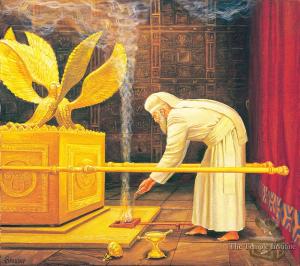Power Mighty in the Blood - Part 2: The Day of Atonement
Before Jesus came, God required His people to atone for their sins on a certain day of the year. This day was called the day of atonement. It was a day where the sins of the people was covered and they appeared clean before God.


Image from templeinstitute.org
Before Jesus came, God required His people to atone for their sins on a certain day of the year. This day was called the day of atonement – Leviticus 23:26-32. It was a day where the sins of the people was covered and they appeared clean before God.
On the day of atonement, the High Priest would enter the Holy of Holies. The Holy of Holies was also known as the Most Holy Place and was the inner sanctuary in the Hebrew tabernacle where the presence of God dwelt. It was forbidden for anyone to enter the Holy of Holies. Only the high priest went into that room, and this he did only once a year. If anyone entered the Holy Place, the repercussion was death. Leviticus 16:2.
Why was the punishment that grievous? Sin! A Holy God cannot behold sin, and sinful man cannot stand before a holy God. (Habakkuk 1:13; Psalm 1:5)
The only day when it was permitted for the high priest to go into the Holy of Holies was on the day of atonement.
Before he went in, the high priest would perform some rituals. He would:
Bathe himself
Put on himself the holy linen tunic, tie a linen sash around his waist, a linen turban around his head,
Come with a young bull (for a sin offering) and a ram (for a burnt offering) for himself and his family.
Take two male kid goats (for a sin offering) and one ram (for a burnt offering). These, he will take from the people because they are for the offering for the people.
To begin the sacrifice, the high priest will first offer his bull as a sin offering for himself and his family, that is making an atonement to God for himself and his household – Leviticus 16:6.
For his sin offering, he will kill the bull, take a censer full of burning coals from the fire off the altar before the Lord, then put the incense upon the fire before the Lord, so that the cloud of incense will cover the Mercy Seat, so that He will not die. He then takes the blood of the bullock and sprinkle it with his finger on the Mercy Seat, seven times. Leviticus 16:13-14.
[The Mercy Seat was the lid over or on top of the Ark of Covenant. Over the Mercy Seat was the cloud (a visible presence of God). When the blood of atonement was sprinkled upon the Mercy Seat, God’s mercy was released upon the people.]
After that, he will take the two goats that the people had brought and present them before God at the tabernacle of the congregation (that is, the entrance of the tabernacle where all worshippers can access) – Leviticus 16:7. Now, the high priest will cast a lot upon the two goats to decide which one will be killed as sin offering and which one will be the scapegoat. When decided, he will kill the goat for the sin offering of the people and sprinkle its blood over the Mercy Seat seven times as he did with his bull offering. Leviticus 16:15.
[The animals are killed in the tabernacle of the congregation at the altar of sacrifice, and the blood taken into the Holy of Holies]. Through these sacrifices, the Holy of Holies is also purified, as well as the tabernacle of the congregation. Leviticus 16:16; Hebrews 9:21-23.
No one is allowed into the tabernacle during this time. Leviticus 16:17.
The high priest will also purify the altar, by putting the blood of the bull and the goat on the horns of the altar (seven times) to set it apart (consecrate it) from the uncleanness of the children of Israel. Leviticus 16:18-19.
When he is done purifying everything, he will take the live goat (the scapegoat) and present it before God to make atonement with it. He will lay both his hands on the head of the goat, and confess over it all the sins of the children of Israel, and put it all on the head of the goat; and then send the goat away (led by a person) into the wilderness of Azazel. The goat will carry on himself the sins of the people into a land that is not inhabited. Leviticus 16:8-10, 20-22.
When he is done with all the sin offerings, the high priest will go into the tabernacle of the congregation, take off the linen garments and leave them there; bathe, put on his regular priestly garments and then come out to offer the two burnt offerings (the one for himself and his family and the other for the children of Israel). Leviticus 16:23-24. He will also burn the fat of the sin offering. Leviticus 16:25.
Someone will take the carcass of the bull and the goats outside the camp to burn them; and both the person who led the scapegoat away and he who burnt the carcass will take off their clothes before returning to the camp. Leviticus 16:27-28.
This concluded the day of atonement. How exhausting!!!
The day of atonement occurred every year on the tenth day of the seventh month – Leviticus 16:29, 34. The people were to humble themselves on that day and do no work – Leviticus 16:30-31, Leviticus 23:26-32; and only the High priest could carry it out – Leviticus 16:32.
Obviously, this was not God’s ultimate plan. His ultimate plan was in Jesus. How does the sacrifice of Jesus compare to the Levitical sacrifice and how is it better? We’ll find out in the next part.



-YX498vOEvBTDMbOK.png)
-YX498vOEvBTDMbOK.png)
-YannNl4R0EIaoeOk.png)
-YannNl4R0EIaoeOk.png)
-AR0zZR1ZERC46LxB.png)
-AR0zZR1ZERC46LxB.png)

